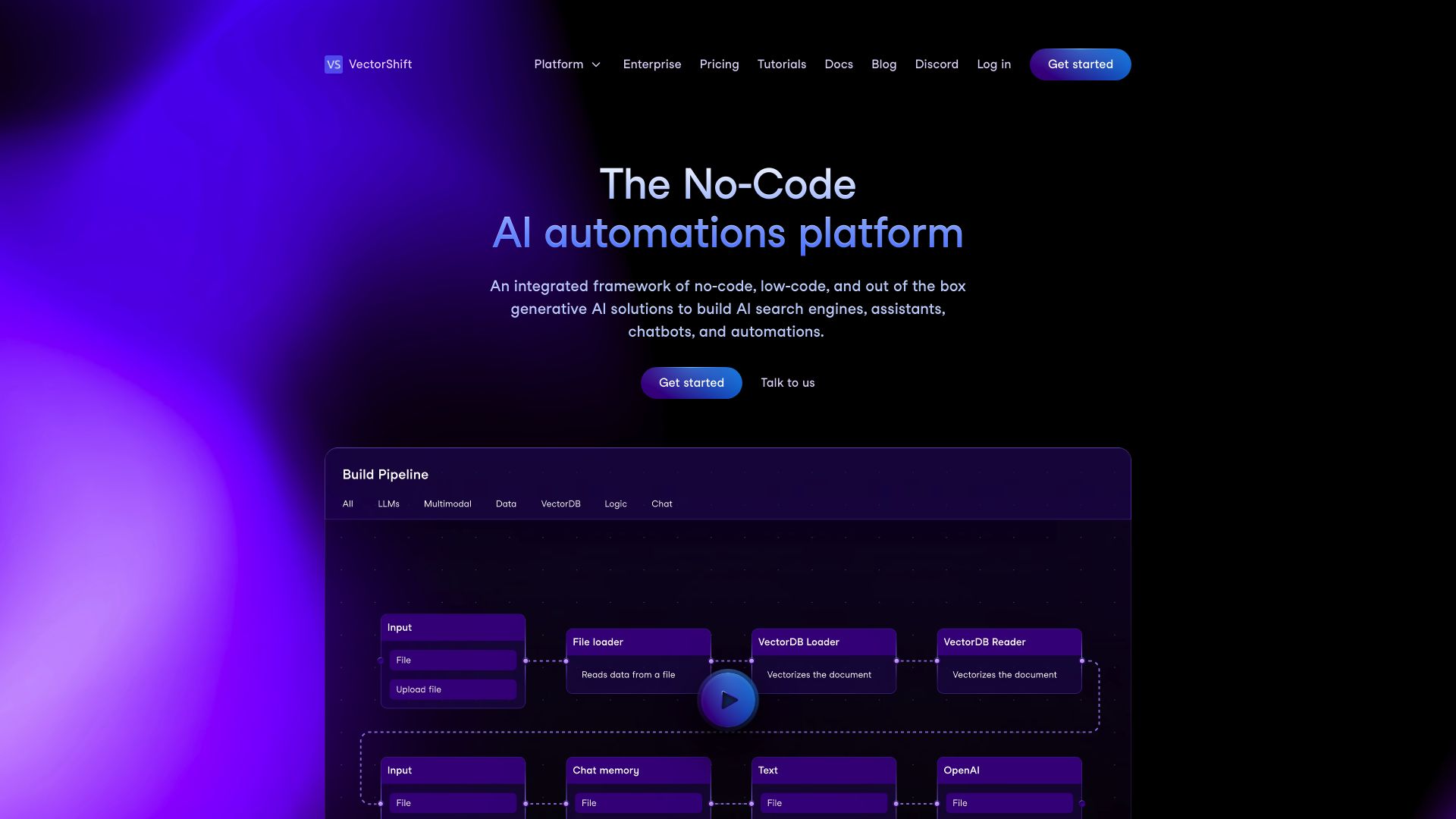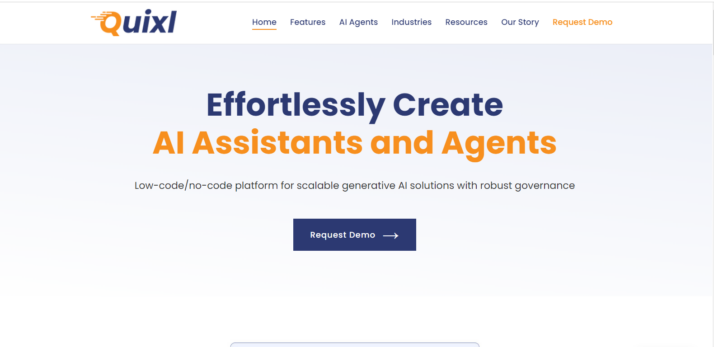VectorShift vs. Quixl AI: Comparing Key Features for AI Development
AI agents revolutionize business operations, automating tasks and enhancing decision-making. VectorShift vs. Quixl AI lead this transformation, offering powerful platforms for AI development and deployment. This comparison examines their key features, strengths, and limitations, guiding you through the complexities of AI integration. We’ll explore how these tools cater to diverse needs, from no-code solutions for business users to advanced capabilities for developers. By dissecting their approaches to workflow automation, deployment options, and industry-specific solutions, we empower you to choose the platform that best aligns with your organization’s AI ambitions. Prepare to dive into a world where AI becomes an accessible, powerful ally in your digital toolkit.
VectorShift Overview
VectorShift empowers users to create and manage advanced AI workflows through an intuitive platform. The software combines a no-code visual builder with a code SDK, catering to both technical and non-technical users. This dual approach democratizes AI development, allowing a wide range of professionals to harness the power of artificial intelligence.
At the core of VectorShift’s offering is the pipeline dashboard, where users can design custom AI workflows or leverage pre-built templates. The platform excels in versatility, supporting diverse applications from chatbots and search functionalities to complex automations and content generation. VectorShift integrates seamlessly with popular services like Google Drive, Slack, and Airtable, centralizing data management and enabling real-time synchronization across applications.


VectorShift shines in its deployment flexibility. Users can export their AI workflows as chatbots, automations, or search tools, with options ranging from simple URL embeds to more complex integrations like WhatsApp bots or API endpoints. This adaptability ensures that businesses can implement AI solutions in ways that best suit their specific needs and existing infrastructure.
VectorShift shines in its deployment flexibility. Users can export their AI workflows as chatbots, automations, or search tools… This adaptability ensures that businesses can implement AI solutions in ways that best suit their specific needs…
The platform’s robust knowledge base feature enhances the capabilities of AI agents by centralizing data and enabling semantic search. This allows for more accurate and contextually relevant responses, improving the overall performance of AI-driven interactions. Additionally, VectorShift’s scheduling capabilities enable users to automate workflows at specific intervals or trigger them based on predefined actions, streamlining operations and reducing manual oversight.
While VectorShift offers a comprehensive suite of features, users should consider their specific requirements when evaluating the platform. The learning curve associated with mastering all of VectorShift’s capabilities may be steep for some users, particularly those new to AI workflow design. Additionally, as with any cloud-based solution, users should carefully review VectorShift’s data handling and security practices to ensure compliance with their organization’s policies.
Quixl AI Overview
Quixl AI, developed by Integra, offers a robust platform for creating and deploying AI agents across various industries. The platform’s standout feature is its no-code AI agent builder, which leverages generative AI and large language models to streamline automation and boost productivity.
Quixl AI simplifies AI adoption through its visual builder interface, allowing users to create sophisticated AI workflows without extensive coding knowledge. The platform supports both development and production environments, enabling seamless testing and deployment of AI agents. Quixl AI’s capabilities extend to memory and context management, multimodal inputs, and integration with various data sources and APIs.
Quixl AI simplifies AI adoption through its visual builder interface, allowing users to create sophisticated AI workflows without extensive coding knowledge.


The platform caters to diverse business needs, from alt-text generation and manuscript assessment to enterprise knowledge search and content editing. Quixl AI’s industry-specific solutions enhance user engagement, personalize learning experiences, and automate administrative tasks in sectors like media, publishing, education, and healthcare.
Quixl AI emphasizes scalability and security, supporting both on-premises and cloud deployments. The platform facilitates AI monetization through its robust API Gateway and ensures data security with advanced transfer mechanisms. However, the platform lacks some features like constrained alignment and specific integrations with Huggingface AIs or Zapier.
While Quixl AI offers a comprehensive suite of tools for AI agent development and deployment, users should consider their specific requirements, especially regarding integrations and customization options, when evaluating the platform against alternatives in the market.
Feature Comparison
VectorShift and Quixl AI offer robust platforms for AI agent development, but key differences emerge in their feature sets. VectorShift excels in its visual builder and no-code options, making AI development accessible to users with varying technical expertise. Its drag-and-drop interface simplifies complex workflow creation, a feature that Quixl AI matches with its own no-code AI agent builder.
Both platforms support hosted agents in development and production environments, ensuring seamless testing and deployment. However, VectorShift’s pipeline dashboard provides a more comprehensive view of AI workflows, enhancing transparency and control. Quixl AI counters with its AI Agents Hub, offering pre-built agents for quick deployment, which VectorShift lacks.
In terms of security, VectorShift integrates with various data sources and supports OAuth, implying secure data handling. Quixl AI emphasizes scalability and security, supporting both on-premises and cloud deployments. However, neither platform explicitly mentions constrained alignment features, leaving a potential gap in ensuring AI behavior aligns strictly with organizational goals.
Feature Comparison Table
| VectorShift | Quixl AI | SmythOS | |
|---|---|---|---|
| CORE FEATURES | |||
| Hosted Agents (Dev, Production) | ❌ | ✅ | ✅ |
| Environments (Dev, Production) | ❌ | ✅ | ✅ |
| Autonomous Agents | ❌ | ✅ | ✅ |
| Explainability & Transparency | ❌ | ✅ | ✅ |
| Debug Tools | ❌ | ✅ | ✅ |
| Multi-Agent Collaboration | ❌ | ✅ | ✅ |
| Audit Logs for Analytics | ❌ | ✅ | ✅ |
| SECURITY | |||
| Constrained Alignment | ❌ | ✅ | ✅ |
| Data Encryption | ❌ | ✅ | ✅ |
| IP Control | ❌ | ✅ | ✅ |
| COMPONENTS | |||
| Huggingface AIs | ❌ | ✅ | ✅ |
| Zapier APIs | ❌ | ✅ | ✅ |
| Classifiers | ❌ | ✅ | ✅ |
| Data Lakes | ❌ | ✅ | ✅ |
| DEPLOYMENT OPTIONS (EMBODIMENTS) | |||
| Staging Domains | ❌ | ✅ | ✅ |
| Production Domains | ❌ | ✅ | ✅ |
| Deploy as GPT | ❌ | ✅ | ✅ |
| DATA LAKE SUPPORT | |||
| Sitemap Crawler | ❌ | ❌ | ✅ |
| YouTube Transcript Crawler | ✅ | ❌ | ✅ |
| URL Crawler | ✅ | ❌ | ✅ |
Best Alternative to VectorShift and Quixl AI
SmythOS stands out as the superior agentic AI automation platform compared to VectorShift and Quixl AI. Our comprehensive solution offers unparalleled ease of use, an extensive feature set, and unlimited use cases that surpass the capabilities of our competitors.
While VectorShift and Quixl AI provide basic AI agent development tools, SmythOS takes automation to the next level. Our intuitive drag-and-drop interface empowers users of all skill levels to create sophisticated AI workflows without writing a single line of code. This democratization of AI development sets us apart, allowing businesses to harness the power of artificial intelligence without the need for extensive technical expertise.
SmythOS excels in its versatility and scalability. Unlike our competitors, we offer a wide array of pre-built integrations and support for various AI models…
SmythOS excels in its versatility and scalability. Unlike our competitors, we offer a wide array of pre-built integrations and support for various AI models, including those from OpenAI, Anthropic, and Hugging Face. This flexibility enables users to tailor their AI agents to specific business needs across industries. Whether you’re looking to automate customer service, streamline data analysis, or enhance decision-making processes, SmythOS provides the tools to make it happen efficiently.
One of the most significant advantages of SmythOS is our commitment to transparency and explainability. While VectorShift and Quixl AI may offer basic debugging tools, our platform goes further by providing comprehensive audit logs, real-time monitoring, and detailed analytics. This level of insight ensures that users can trust and understand the decisions made by their AI agents, a critical factor in industries where accountability is paramount.
Furthermore, SmythOS shines in its deployment options and scalability. Our platform supports seamless deployment across multiple environments, including development and production servers, with the ability to scale effortlessly as your needs grow. This robustness, combined with our advanced security features like data encryption and IP control, makes SmythOS the ideal choice for businesses of all sizes, from startups to large enterprises.
Conclusion
VectorShift and Quixl AI offer powerful AI agent development platforms, each with unique strengths. VectorShift’s intuitive visual builder and flexible deployment options empower users across technical skill levels. Quixl AI’s industry-specific solutions and emphasis on scalability cater well to enterprise needs. Both platforms deliver robust AI integration capabilities, streamlining workflow automation and enhancing productivity.
However, SmythOS emerges as the superior choice, offering unparalleled versatility and ease of use. Our drag-and-drop interface, extensive integration ecosystem, and support for multiple AI models provide a comprehensive solution for businesses of all sizes. SmythOS’s ’Create Once, Deploy Anywhere’ approach allows seamless integration across various platforms, from chatbots to APIs, giving users unmatched flexibility in implementing AI solutions.
SmythOS stands out with its ability to orchestrate multi-agent systems, enabling complex task collaboration that surpasses the capabilities of VectorShift and Quixl AI. Our platform’s pre-built templates and API integrations significantly reduce development time, allowing users to focus on innovation rather than technical implementation.
We invite you to experience the future of AI development with SmythOS. Create a free SmythOS account today and join the AI revolution. With our 30-day money-back guarantee and unlimited agent creation, you can explore the full potential of AI-driven automation risk-free. Unlock limitless AI integrations and transform your workflow with SmythOS – where innovation meets simplicity.
Last updated:
Disclaimer: The information presented in this article is for general informational purposes only and is provided as is. While we strive to keep the content up-to-date and accurate, we make no representations or warranties of any kind, express or implied, about the completeness, accuracy, reliability, suitability, or availability of the information contained in this article.
Any reliance you place on such information is strictly at your own risk. We reserve the right to make additions, deletions, or modifications to the contents of this article at any time without prior notice.
In no event will we be liable for any loss or damage including without limitation, indirect or consequential loss or damage, or any loss or damage whatsoever arising from loss of data, profits, or any other loss not specified herein arising out of, or in connection with, the use of this article.
Despite our best efforts, this article may contain oversights, errors, or omissions. If you notice any inaccuracies or have concerns about the content, please report them through our content feedback form. Your input helps us maintain the quality and reliability of our information.
